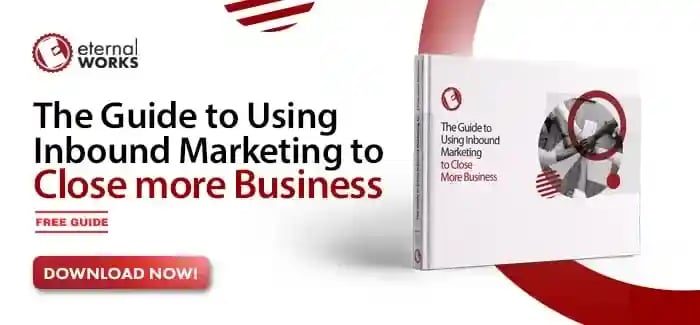Marketing is all about establishing a connection with your potential customers. There are two ways to do this: by going directly to them or getting them to come to you—which essentially sums up the concepts of inbound and outbound marketing. Keep reading for a deep dive into the differences between these marketing strategies.
What is Inbound Marketing?
The foundation of inbound marketing is getting the customer to come to you. It relies on the fact that many consumers—63 percent of shoppers, in fact—start their shopping journey online. They surf the web searching for products, services, or content that can satisfy their needs.
An inbound marketing strategy involves developing content to help them find what they are looking for (your products or services) without pushing them to buy. The idea is to answer any questions they may have to aid in their journey to purchase so when they are ready to buy, you're the obvious choice as you've helped them along the way. As such, the customer decides to buy from you because they feel you are trustworthy.
What is Outbound Marketing?
Outbound marketing is the opposite of inbound marketing. While the latter is subtle, outbound marketing tactics tend to be loud and aggressive. The idea is to make a sales pitch, pushing anyone who sees it to buy your products or services and plastering it anywhere you think potential customers will see it. An excellent example would be a billboard ad on a busy highway or a random ad on TV.
How is Inbound Marketing Different from Outbound Marketing?
The differences between inbound and outbound marketing are stark. Here is an overview of each strategy's strengths and weaknesses.
Advantages
Here are some advantages of inbound and outbound marketing:
Advantages of Inbound Marketing
- It is cost-effective and cheaper than mass (outbound) marketing.
- It helps the brand develop trust and nurtures loyalty among your clients.
- It makes you appear knowledgeable about your niche, which builds brand authority and awareness.
- It has long-term effects and benefits because the content remains on your platforms for as long as you want.
Advantages of Outbound Marketing
- Adverts are easily recognizable and grab people's attention.
- It can generate immediate results.
- Mass adverts help spread brand awareness and offerings.
Disadvantages
Here are some disadvantages of inbound and outbound marketing:
Disadvantages of Inbound Marketing
- Inbound marketing is time-intensive as the content requires continuous maintenance and evolution.
- You should invest in digital tools and services to run your inbound marketing campaigns efficiently.
Disadvantages of Outbound Marketing
- It is costly, especially when buying ad space on mass media platforms like TV.
- The ads cannot appeal to everyone; as a result, outbound marketing is generalized.
- It is not cost-effective because the ads don't appeal to everyone in the target audience.
- It isn't easy to measure the performance and efficiency of outbound marketing campaigns.
- People have ways of tuning out ads. It's also worth mentioning that 25 percent of internet users in the US use ad blockers.
Tactics
Here is an overview of some of the most popular and efficient inbound and outbound marketing tactics:
Inbound Marketing Tactics
Some of the most efficient inbound marketing tactics include:
- Search Engine Optimization (SEO)
SEO entails optimizing your website and other online platforms for Google for a higher rank on search engine results pages (SERPs). Google ranks their results based on web design and content quality, and top-ranking websites get most of the traffic. As such, SEO essentially entails improving every aspect of your online platform.
- Blogging and Content Development
Blogs and articles are an excellent way to inform and educate your audience. Blogging should incorporate SEO tactics such as keyword research and optimization. It is also essential to develop other types of content, such as videos and images. And it's worth noting that video content's popularity is soaring among audiences.
- Social Media Engagement
Social media is undoubtedly the largest digital marketing platform. Engaging with your current and potential customers on social media through posts and one-on-one conversations will help establish trust and loyalty.
It's important to understand that inbound marketing requires a holistic approach whereby different tactics work together. For example, SEO entails dozens of marketing tactics.
Outbound Marketing Tactics
Some of the most efficient outbound marketing tactics include:
- Cold Email Outreach
Cold email outreach can be an effective strategy for businesses looking to expand their reach and generate leads. However, it's important to continually evaluate and refine your approach based on the responses and feedback you receive.
- Mass Media Ads
Mass media advertising entails posting ads on mass media platforms such as TV, newspapers, and radio. It is expensive but you can reach a large audience this way.
- Social Media Advertising
You can also create ads on social media platforms like LinkedIn, Facebook, YouTube, TikTok, and Twitter, which differs from social media engagement because your audience didn't start the conversation.
How to Choose the Best Strategy for Your Business
Inbound and outbound marketing have marked differences that suit varying purposes. Here is an overview of when and where it is appropriate to use either marketing strategy:
When to Use Inbound Marketing
Inbound marketing is recommended in the following situations:
- When building your digital infrastructure (remember that this involves aspects such as web design and SEO)
- When looking for organic, long-lasting results for your marketing campaigns (outbound marketing puts you on top of SERPs only as long as you pay)
- When looking to improve your brand's authority and credibility through an extensive collection of informative content
It is also worth noting that inbound marketing requires robust digital infrastructure. Additionally, most inbound marketing strategies are long-term in nature.
When to Use Outbound Marketing
Outbound marketing is recommended in the following situations:
- When you have a budget large enough to cover the cost of buying ad spaces on platforms such as mass media
- When you're looking for more immediate results
- When you don't have the right digital infrastructure and cannot wait long enough to set it up
There are dozens of other reasons for using outbound marketing. Ultimately, it is smart to combine both strategies.
To further guide you on the path of mastering both inbound and outbound marketing strategies, download our guide on using inbound marketing to close more business to help kickstart your inbound marketing journey.



